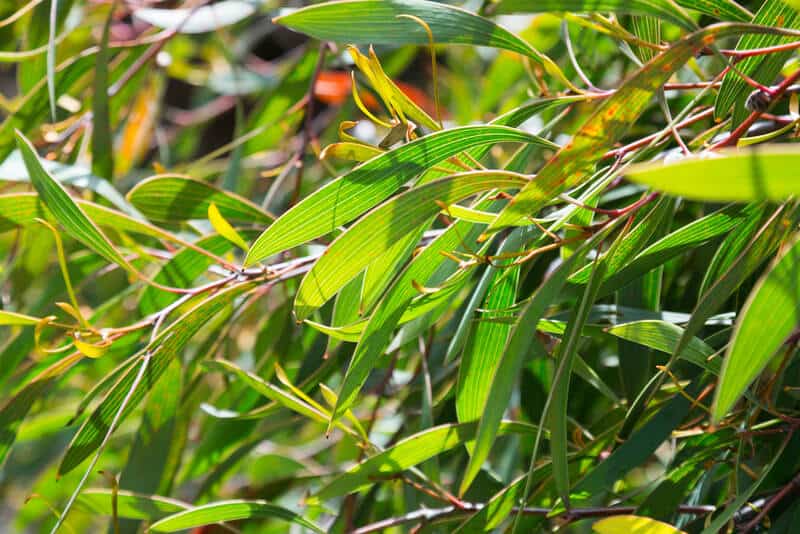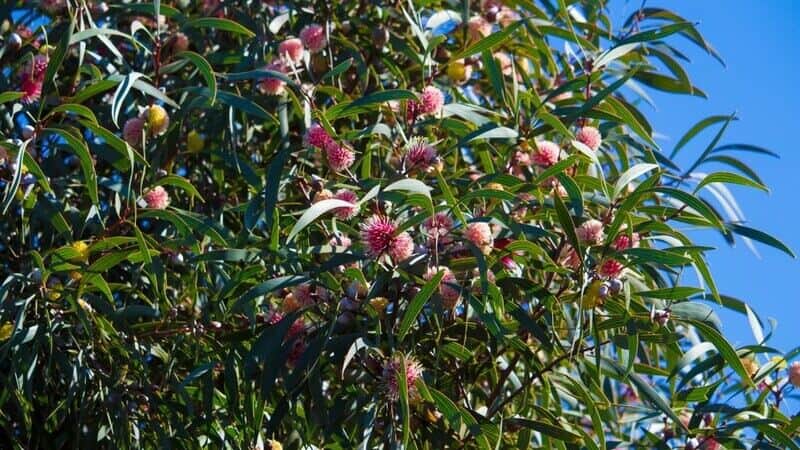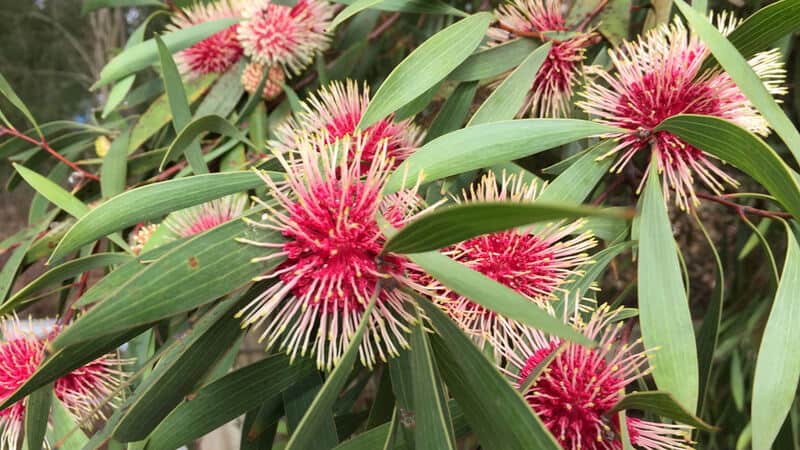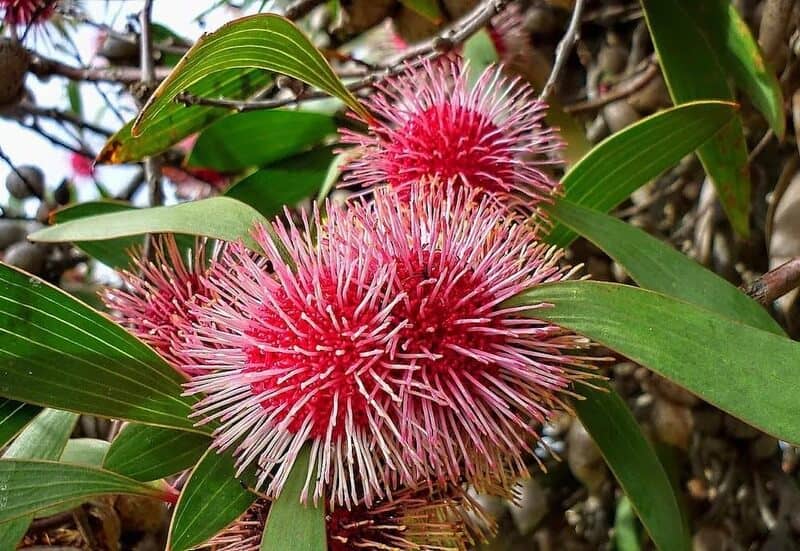If you want a native plant that will transform your garden from boring to breathtaking, look no further than the Hakea Laurina. This no-fuss upright shrub will bring any outdoor space to life with its captivating flowers and beautiful foliage.
See what makes the Hakea Laurina a sensational feature plant in your garden — and why we’re positive you’ll go wild about it.
A brief description of the Hakea Laurina
With globular red flowers, laurel-shaped leaves, and smooth gray bark, the Hakea Laurina is definitely one memorable character. You may know the Hakea Laurina by its other names: Pincushion Hakea, Pincushion Flower, Pincushion Tree, West Australian Cushion Flower, and Kodjet.
There isn’t anything tame or timid about this gorgeous gal. She is a curious-looking sort when compared to the usual roses and daisies — you’ll know by her flower’s pin-like spines that dainty petals aren’t her thing.
Her evergreen growth habit makes her a perennial, which means you’ll get to enjoy her lush foliage all year long. You don’t need to fuss with her care, either.
Your Pincushion Hakea is content with well-draining soil, ample sunlight, and all the environmental conditions that make her a true Australian native flowering plant. She especially loves the coastal region of south-western Australia, where she gets to bask in endless sun and sand. You’ll also find plenty of Hakea varieties thriving in Western Australia, where the soil has good drainage.
That said, the Hakea Laurina does get to go around the globe, particularly in Italy or America where she has achieved celebrity status as a street tree. Back home, her versatility, robust structure, and fast growth make her a crowd favourite for cut flower arrangements, hedges, and screens. With an edgy appearance and a low maintenance nature, the Hakea Laurina is one heck of a gardening star.
Structure
Depending on its environment, the typical Hakea Laurina can be a large shrub or small tree. A mature plant can reach up to 6m when given proper care. Due to its size and upright habit, it fares better in an open space, such as a playground or a soccer field.
Pincushion Flower plants prefer to be unbridled when growing. Pots may prove to be too cramped for them, unless you get a dwarf Hakea Laurina. This smaller variety carries the same physical characteristics of the regular-sized Pincushion Hakea and is just right for tiny spaces.
Foliage
When it comes to beautiful foliage, the leaves of the Hakea Laurina may just be the best frond you’ve been looking for. The laurel-shaped leaves are so eye-catching that the plant was named after its foliage’s appearance — hence the name, Hakea Laurina.
Each leaf is lanceolate in shape, with a slightly blue-green colour. The typical leaf length reaches up to 15cm.
Flower
Having a Hakea Laurina in your garden is handy when you need to make a stylish cut flower arrangement. Fair warning — this isn’t your ordinary bunch of flowers!
Pincushion Hakea flowers are round in shape and measure up to 5cm in diameter. Protruding from the red ball are 120-190 spines. These projecting long styles — together with the cherry red or soft cardinal colour of the flower ball — make up Mother Nature’s version of a pincushion.
If that’s not enough to let your love for the Pincushion Flower blossom, how about this: Pincushion Hakeas are pollinator magnets. Butterflies, bees, and birds love Hakea Laurina plants for their faint, honey-scented blooms.
Watch out for pollinating garden visitors during the flowering season — you’ll be sure to get plenty of them when the flowers of the Hakea plant are in full bloom in July. As early as December, however, you may start to see new flower buds appear. Flowering season usually starts in April, then ends as August comes to a close.
How to care for a Hakea Laurina plant
Aside from its dazzling form, the Pincushion Flower is hardy and easy to care for. These are the elements you need for your plant to grow healthy and vital-looking:
Well-drained soil
Hakeas, in general, prefer dry to medium soil. They can thrive in different soil types (even sandy clay) as long as the planting mix is lime-free and has good drainage. Sandplains are their natural habitat, however, and provide the best soil type for these plants.
Full sun
Position your plant in a sunny spot in your garden. Exposure to full sun is a must if you want to achieve a compact, rounded look for your Hakea Laurina tree.
Note: A Hakea plant that gets plenty of sunlight has more blooms and vital-looking foliage. Under partial shade, your Hakea Laurina will still thrive, but it will bear less flowers and have a more slender appearance.
Little watering
The Hakea Laurina is a fantastic plant when it comes to watering. It doesn’t need plenty of water to survive and is fairly drought tolerant.
Temperate climate
Because they are acclimated to Australian weather conditions, Hakeas grow well in temperate regions. They are frost tolerant and can survive even in extremely cold weather. Their flowers tend to look smaller under these conditions, however.
Moderate pruning
Prune your Hakea Laurina when you see new growth. This will help manage the size and shape of your plant, and protect it from leaf mould.
Cut back the tip growth 10-20cm from its end to keep your plant looking robust and healthy. Do this regularly after flowering. Avoid pruning thick woody branches as they may not grow back.
Hakea Laurina propagation
Propagating from a cutting may prove to be unsuccessful because the Pincushion Hakea is a shallow-rooted plant. We recommend either of these two options when propagating a Hakea Laurina:
- Growing your plant from seed
- Sourcing a young plant from a nursery
To grow a Hakea Laurina from seed, the first thing you need to do is harvest the pods. Use sharp secateurs and wear gloves for this task, as the seed pods can be sharp. Put the pods inside a paper bag and place them in a warm area in your home. Under the window of your car works just as well!
When the pods crack open, gather the little seeds and plant them in a well-drained potting mix. Cover them slightly with vermiculite, moisten regularly, and allow them to germinate. This usually takes about two to three months. Transfer them to a bigger planting site where they can grow to their full potential. Remember to water your plants regularly until they are well-established.
Note: Pick a sunny spot when transplanting, and provide structural support to protect your plants from strong winds.
FAQs
1. Is Hakea an Acacia?
While some Acacia varieties have leaves that resemble Hakea foliage, Acacias and Hakeas are two different plant species.
They are both native Australian plants but belong to different plant families — Acacias are from the Mimosaceae family, while Hakeas are from the Proteaceae family.
2. What is the family of Hakea?
Hakeas, including the Hakea Laurina, Hakea Salicifolia, Hakea Petiolaris, Hakea Nodosa, and Hakea Decurrens, belong to the Proteaceae family.
3. What is the scientific name for Hakea?
The scientific name for Hakea is the same as its common name — Hakea.
4. Can you prune Hakea Laurina?
You can trim a Hakea Laurina plant with light or moderate pruning. Cutting new growth back while the plant is young will help keep the foliage robust and dense.
You may be surprised to find your plant growing faster than expected, however. If keeping up with your plant’s voracious growth is proving to be quite a hassle on your schedule, you can hire professional hedge trimmers to maintain your plants for you. That way, you won’t have to worry about carving time out of your schedule to prune your Hakeas often.
5. What are the common problems of the Hakea Laurina?
Aside from being shallow-rooted, your Pincushion Tree won’t be giving you a lot of gardening problems. The occasional root rot fungus can appear, but this hardy native plant can recover well as long as it is planted in well-draining garden soil.






